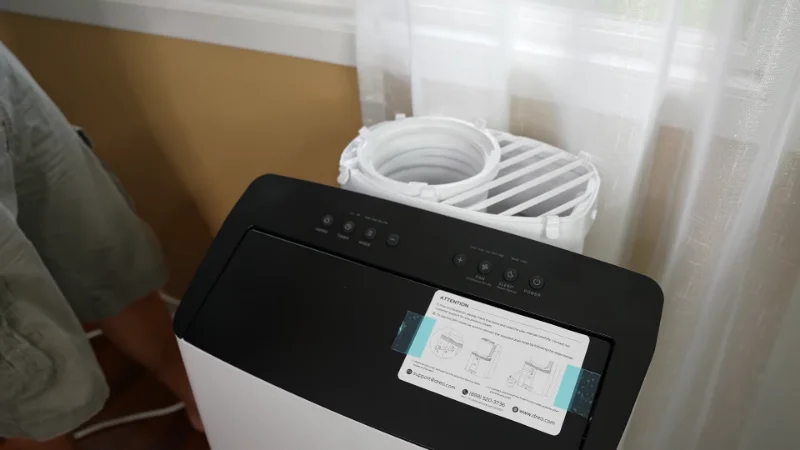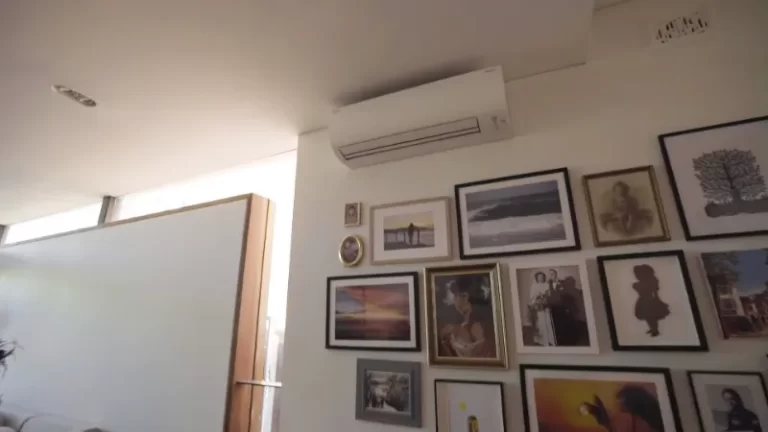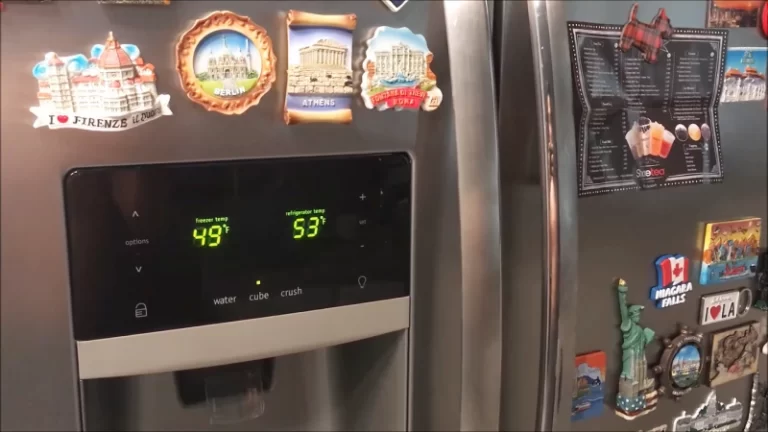Why is My Toshiba Portable Air Conditioner Spitting Water?
If you own a Toshiba portable air conditioner, you may have experienced the frustrating issue of the unit “spitting water” or overflowing the drip pan. This problem can occur for a variety of reasons, ranging from high humidity levels in the room to a clogged air filter or vent.
In some cases, it may even be due to a problem with the unit’s condenser or evaporator coils. In this article, we will discuss the causes of excess condensation in portable air conditioners and provide some troubleshooting steps to help you fix the issue.
If the problem persists, we will also discuss the importance of seeking professional assistance and referring to the manufacturer’s instructions for further guidance. So, if you are facing this issue with your Toshiba portable air conditioner, read on to learn more about how to resolve it.
You'll Learn About
Why is My Toshiba Portable Air Conditioner Spitting Water?
Toshiba portable air conditioners are designed to efficiently cool and dehumidify a room or space. However, it is not uncommon for portable air conditioners to produce a certain amount of condensation, which is typically collected in a drip pan located at the base of the unit. In some cases, the unit may produce more condensation than usual, causing it to “spit water” or overflow the drip pan.
There can be several reasons for a Toshiba portable air conditioner to produce excess condensation, including high humidity levels in the room, a clogged air filter or vent, or a problem with the unit’s condenser or evaporator coils.
To troubleshoot the issue, it is recommended to check the humidity level in the room, clean or replace the air filter, and ensure that all vents and air inlets are free of debris. If the issue persists, it may be necessary to have the unit serviced by a professional or refer to the manufacturer’s instructions for further guidance.

Causes of Excess Condensation in Portable Air Conditioners
A problem with the unit’s condenser or evaporator coils can also lead to excess condensation in a portable air conditioner. If these components become dirty or damaged, it can affect the unit’s ability to properly cool and dehumidify the air, resulting in increased condensation production. This issue may require professional repair or replacement of the affected components.
High Humidity Levels
One of the main causes of excess condensation in portable air conditioners is high humidity levels in the room. When the air in a room is more humid, the air conditioner has to work harder to cool it, which can lead to increased condensation production.
This is because the unit’s evaporator coils absorb moisture from the air as it cools, which is then collected in the drip pan. If the humidity level in the room is too high, the unit may not be able to keep up with the amount of moisture it is removing, resulting in excess condensation.
Excess Condensation
Another common cause of excess condensation in portable air conditioners is a clogged air filter or vent. When these areas become blocked by dust, dirt, or other debris, it can restrict the flow of air through the unit, causing it to work harder and produce more condensation.
It is important to regularly clean and replace the air filter and ensure that all vents and air inlets are free of obstructions to prevent this issue.
Sweating Ducts
There may be problems in the ductwork that can result in excess condensation in a portable air conditioner.
For instance, the ducting may contain cracks, be brittle, leak, or have loose joints or connections. When air passes through these areas, it may have trouble maintaining a consistent temperature and may cause a higher level of condensation than normal.
A portable air conditioner may be affected by ductwork that has been treated with harsh cleaning chemicals, which may shorten its life. It is important to frequently check the air ductwork for any leaks or obstructions and make sure that all ductwork is kept clean and free of obstructions.
Poor installation or improper duct installation can also lead to excess condensation. The unit may not be able to draw enough air from the room because of gaps or improperly designed ductwork. This can cause the unit to work harder to cool the air, resulting in increased condensation production. In this case, the drain might make noise.
Drips From Outside the Unit Cabinet
Another cause of excess condensation in portable air conditioners is dripped that occur from the outside of the unit cabinet. Because the unit has a fan, it can produce a slight breeze, which can move the air that is being cooled, causing it to bypass the unit’s evaporator coils and be ejected outside of the unit.
This can happen if the unit has a duct inlet on the inside wall or if the unit has been set up in a bathroom or shower. If a fan does not have a cover over the ventilation inlet, this can lead to drips from the unit, which can cause condensation on the unit’s exterior.
If you experience excessive condensation on your portable air conditioner, it is important to ensure that it is working properly by checking the following:
- Is the unit receiving and distributing proper amounts of heat and cold?
- Is the cooling and heating components performing as expected?
- Is the air flow from the unit’s vents moving the air through the unit properly?
- Are the components that contain the evaporator coils and the drip pan dirty or damaged?
- Do you have clogged air vents?
- Are there any signs of water damage to the unit?
- Have you ever experienced condensation on your portable air conditioner?
Troubleshooting Steps for Excess Condensation
If you are experiencing excess condensation in your Toshiba portable air conditioner, there are several troubleshooting steps you can try to resolve the issue:
Check the Humidity Level in the Room
It is important to keep the humidity level in the room within a comfortable range, as high humidity can lead to increased condensation production. You can use a hygrometer to measure the humidity level in the room and adjust the unit’s settings or use a dehumidifier if necessary. Some also might feel line vibration.
Clean or Replace the Air Filter
A dirty or clogged air filter can restrict the flow of air through the unit, causing it to work harder and produce more condensation. It is recommended to clean or replace the air filter at least once a month to prevent this issue.
Ensure That All Vents and Air Inlets Are Free of Debris
If the unit’s vents or air inlets become blocked by dust, dirt, or other debris, it can restrict the flow of air and cause the unit to produce excess condensation. Make sure to regularly clean and dust these areas to keep the unit functioning properly.
If these troubleshooting steps do not resolve the issue, it may be necessary to seek professional assistance or refer to the manufacturer’s instructions for further guidance.
Seeking Professional Assistance
If you have tried the troubleshooting steps mentioned above and your Toshiba portable air conditioner is still producing excess condensation, it may be necessary to seek professional assistance. A certified technician will be able to diagnose the issue and provide the necessary repairs or maintenance to resolve the problem.
When seeking professional assistance, it is important to follow the manufacturer’s instructions for servicing the unit. This will ensure that the repair or maintenance is done correctly and that the unit’s warranty remains valid. The manufacturer’s instructions may also provide additional troubleshooting steps or recommendations for resolving the issue.
It is also a good idea to keep the manufacturer’s contact information and a copy of the owner’s manual handy in case you need to refer to it in the future. This will make it easier to get in touch with the manufacturer or a certified technician if you encounter any other issues with your Toshiba portable air conditioner.
Tips for Preventing Excess Condensation in Your Toshiba Portable Air Conditioner
Here are some additional tips for preventing excess condensation in your Toshiba portable air conditioner:
Install the Unit in a Well-ventilated Area
Proper ventilation is important for any air conditioning unit, as it helps to dissipate the heat and moisture produced by the unit. Make sure to install the unit in a well-ventilated area to allow for proper airflow and reduce the risk of excess condensation.
Use the Unit’s Dehumidify Setting
Most portable air conditioners have a dehumidify setting that is specifically designed to remove excess moisture from the air. Using this setting can help to reduce the amount of condensation produced by the unit.
Keep the Unit Level
It is important to keep the unit level to ensure that the condensation produced by the unit is properly collected in the drip pan. If the unit is tilted or not level, the condensation may spill out and cause a mess.
Check the Unit’s Air Filter Regularly
A dirty air filter can restrict the airflow through the unit and cause it to work harder, leading to increased condensation production. It is important to check and clean or replace the air filter regularly to prevent this issue.
Follow the Manufacturer’s Instructions for Proper Installation and Maintenance
It is important to follow the manufacturer’s instructions for proper installation and maintenance of your portable air conditioner to ensure that it is functioning properly and to prevent excess condensation and other issues. Be sure to carefully read the owner’s manual and follow any recommended maintenance procedures.
Conclusion
Excess condensation in a Toshiba portable air conditioner can be caused by various factors, including high humidity levels in the room, a clogged air filter or vent, or a problem with the unit’s condenser or evaporator coils. By following the troubleshooting steps discussed in this article, you can resolve the issue and get your portable air conditioner back to functioning properly. However, if the problem persists or you are unable to fix it on your own, it may be necessary to seek professional assistance and follow the manufacturer’s instructions for servicing the unit.
It is important to regularly maintain and clean your portable air conditioner to prevent excess condensation and other issues. This includes checking and replacing the air filter, cleaning the vents and air inlets, and ensuring that the unit is functioning properly. By taking good care of your portable air conditioner, you can extend its lifespan and enjoy its cooling and dehumidifying benefits for years to come.



![Polarity Reversed on Furnace [Symptoms, Causes, Fixes]](https://fixitinthehome.com/wp-content/uploads/2023/02/Polarity-Reversed-on-Furnace-768x432.webp)